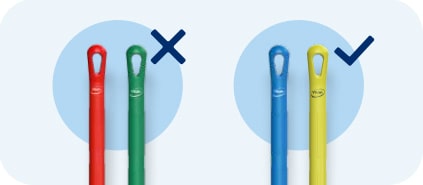Colour coding helps ensure greater food safety by making it easier to more effectively separate processes, zones and equipment in your food production setup and thus minimise cross-contamination.
Colour coding can be embedded into your work processes as a natural part of your Good Manufacturing Practice (GMP), or as a proactive risk reduction step as part of your HACCP prerequisite programme.
Use colour-blind friendly combinations.
1 in 12 men and 1 in 200 women are colour-blind. Use different shades and contrasts to make it easier for colour-blind staff to differentiate colours. If in doubt, take a photo of the colours and convert the photo into black and white. If you can tell the difference, the shade differentiation is strong enough.



